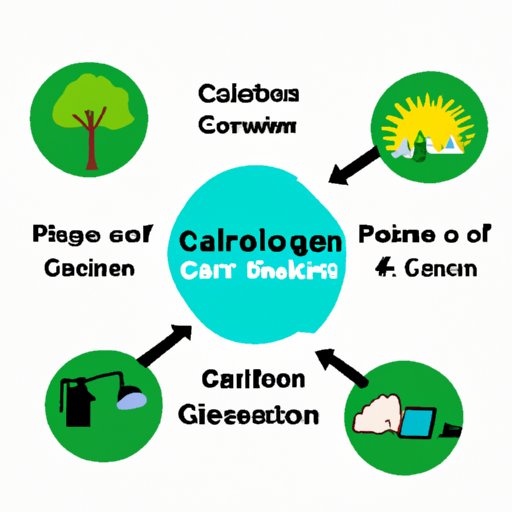Introduction
The carbon cycle is fundamental in supporting life on earth as we know it. It is a vital natural process for regulating the levels of carbon in the atmosphere to maintain an optimal biosphere. This article will explore the carbon cycle & its importance, highlighting the role of human activities and other factors that impact the cycle to provide insight into how individuals can better take care of the environment and make a positive impact on the cycle.
The Basics of the Carbon Cycle
The carbon cycle is the process by which carbon compounds move between different carbon reservoirs in the earth’s ecosystem. The cycle has several key steps, including photosynthesis, respiration, decomposition, and combustion. Each of these steps plays an essential role in the environment, and the slightest changes in one step can have a significant impact on the entire cycle, ultimately affecting the composition of the earth’s atmosphere.
The Importance of Photosynthesis
Photosynthesis is one of the most critical steps of the carbon cycle. It is the process by which plants convert carbon dioxide, water, and sunlight into food, releasing oxygen as a byproduct. Without photosynthesis, oxygen levels would decrease over time, which could result in the extinction of numerous species. Plants are also the primary source of food for herbivores, and the transfer of carbon from plants to animals in the food chain is crucial in sustaining life on earth.
The Effects of Deforestation
Deforestation has numerous implications for the carbon cycle, as forests are some of the largest carbon sinks. The removal of trees leads to more carbon dioxide emissions as trees absorb and store carbon dioxide during photosynthesis. With the removal of forests, there is a decrease in the number of trees absorbing carbon dioxide, which ultimately leads to an increase in atmospheric carbon dioxide levels. This results in climate change, a shift in rainfall patterns, and the eventual loss of biodiversity in the ecosystem.
The Role of Oceans
The oceans are the largest carbon reservoir on earth and play a crucial role in regulating the levels of atmospheric carbon dioxide. The vast majority of carbon is stored in the deep ocean, but it is continually exchanged with the atmosphere and the surface waters through various natural processes. With the increase in carbon dioxide emissions caused by human activity and deforestation, the ocean’s capacity to absorb and store carbon has decreased. The excess carbon dioxide in the water also leads to an increase in ocean acidity levels, which negatively impacts the marine ecosystem’s health.
The Impact of Climate Change
Climate change is one of the most significant impacts of the carbon cycle’s disruption, which results in extreme weather patterns, melting glaciers, and rising water levels. Carbon dioxide emissions trap heat in the atmosphere, leading to a gradual rise in global temperatures, and changes in rainfall patterns. These changes negatively impact agriculture, water availability, and the environment. Although carbon dioxide occurs naturally, the impact of human activities on the carbon cycle accelerates climate change and increases the likelihood of natural disasters.
The Role of Humans in the Carbon Cycle
Human activity is one of the primary drivers of carbon dioxide emissions in the atmosphere, leading to a disruption in the natural carbon cycle. Activities such as burning fossil fuels, deforestation, and industrial processes contribute significantly to the increase in carbon dioxide levels. It is essential to start taking steps to reduce human impact on the environment to restore the balance of the carbon cycle.
The Natural Carbon Cycle
The natural carbon cycle is a crucial process that has been occurring for millions of years, and it plays a significant role in maintaining the optimal biosphere. The cycles involve numerous organisms like plants, animals, soil, and microbes. These organisms are dependent heavily on toxins, nutrients, and waste products produced within the cycle to stay alive, ensuring a constant balance of carbon levels in the atmosphere. To prevent a further disruption in the carbon cycle, it is crucial that humans preserve and protect natural ecosystems.
Conclusion
The carbon cycle is a complex, yet vital natural process for regulating the health of the earth’s ecosystem. Its disruption could lead to catastrophic environmental consequences, negatively impacting human life. It is crucial that we take individual responsibility for reducing our carbon footprint by taking steps such as reducing energy consumption and reforestation. With collective effort in place, we can restore the balance of the carbon cycle, maintain a healthy environment and ensure the sustainability of human life on earth.
